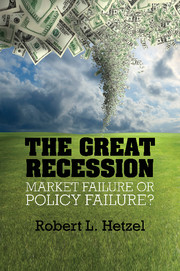Book contents
- Frontmatter
- Contents
- Figures
- Tables
- Preface
- One The 2008–2009 Recession
- Two Recessions
- Three The Great Contraction
- Four Monetary Policy and Bank Runs in the Great Depression
- Five Vigorous Recovery and Relapse
- Six Interwar International Monetary Experiments
- Seven Identifying the Shocks that Cause Recessions
- Eight From Stop-Go to the Great Moderation
- Nine Controlling Bank Risk Taking
- Ten The Housing Crash
- Eleven Bubble Trouble
- Twelve What Caused the Great Recession of 2008–2009?
- Thirteen What Caused the Great Leverage Collapse?
- Fourteen The Distinctions Between Credit, Monetary, and Liquidity Policy
- Fifteen Fed Market Interventions
- Sixteen Evaluating Policy
- Seventeen The Business Cycle
- Eighteen Why Is Learning So Hard?
- Nineteen How Should Society Regulate Capitalism?
- Postscript
- Bibliography
- Index
Ten - The Housing Crash
Subsidizing Housing and Bank Risk Taking
Published online by Cambridge University Press: 05 May 2012
- Frontmatter
- Contents
- Figures
- Tables
- Preface
- One The 2008–2009 Recession
- Two Recessions
- Three The Great Contraction
- Four Monetary Policy and Bank Runs in the Great Depression
- Five Vigorous Recovery and Relapse
- Six Interwar International Monetary Experiments
- Seven Identifying the Shocks that Cause Recessions
- Eight From Stop-Go to the Great Moderation
- Nine Controlling Bank Risk Taking
- Ten The Housing Crash
- Eleven Bubble Trouble
- Twelve What Caused the Great Recession of 2008–2009?
- Thirteen What Caused the Great Leverage Collapse?
- Fourteen The Distinctions Between Credit, Monetary, and Liquidity Policy
- Fifteen Fed Market Interventions
- Sixteen Evaluating Policy
- Seventeen The Business Cycle
- Eighteen Why Is Learning So Hard?
- Nineteen How Should Society Regulate Capitalism?
- Postscript
- Bibliography
- Index
Summary
The severity of the boom-bust cycle in housing came from the cutting action of two blades of a scissors. The first blade was a government push to increase home ownership rates. Given the relatively inelastic supply of housing, the result was a sustained increase in house prices. The second blade was a financial safety net that encourages risk taking by banks. Given the increase in house prices and given the incentives to risk taking, banks concentrated their portfolios in housing mortgages (Hetzel 2009a).
Using the GSEs to Subsidize Housing Off Budget
Understanding the role of the subprime housing crisis in the 2008–2009 financial crisis requires understanding the role played by the government-sponsored enterprises (GSEs). They increased the demand for the housing stock, helped to raise the homeownership rate to an unsustainable level, and, as a consequence of a relatively inelastic supply of housing due to land constraints, contributed to a sharp rise in housing prices. That rapid rise in housing prices made the issuance of subprime and Alt-A loans appear relatively risk free.
- Type
- Chapter
- Information
- The Great RecessionMarket Failure or Policy Failure?, pp. 170 - 186Publisher: Cambridge University PressPrint publication year: 2012



